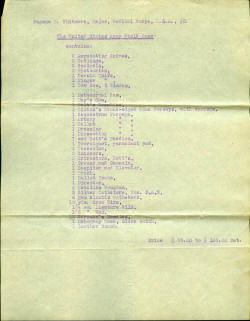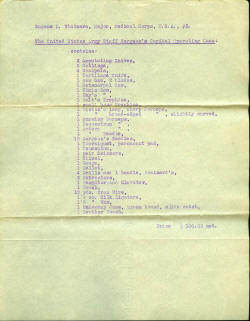Instrument sets specified by the U.S. Army Medical Department during the Civil War
Geo. Tiemann's: U. S. Army Capital , Field, and Minor Operating Cased sets
(1) The Capital Operating Case contained: 2 amputating knives (one long, one medium), 2 catlings (one long, one medium), 4 scalpels, 1 cartilage knife, 1 capital saw (long, bow, two blades), 1 metacarpal saw, 1 chain saw, 1 Hey's saw, 1 trephine (conical), 1 trephine (small crown), 1 bone forceps (Liston's long, sharp, spring handle), 1 bone forceps (broad edged, slightly carved, spring handle), 1 bone forceps (gnawing, spring handle), 1 bone forceps (sequestrum, spring handle), 1 artery forceps, 1 artery needle, 1 artery needle key, 12 surgeon's needles, 1 tourniquet screw with pad, 1 tenaculum, 1 scissors, 1 chisel, 1 gouge, 1 mallet, 4 drills (with one handle), 2 retractors, 1 raspatory, 1 elevator, 1 brush, 12 yards suture wire (iron), ¼ oz. ligature silk. 1/8 oz. wax, 1 mahogany case (brass bound, slide catch), 1 leather pouch.
(2) The Minor Operating Case contained: 1 amputating knife, 3 scalpels, 2 bistouries, 1 hernia knife, 1 finger knife, 1 artery forceps, 1 ball forceps, 1 gullet forceps, 1 dressing forceps, 1 dissection forceps, 1 artery needle, 1 artery needle key, 12 surgeon's needles, 1 tenaculum, 2 scissors, 1 trocar and canula. 1 Belloc's canula, 1 bullet probe, 1 director, 1 cutting pliers (small), 6 steel bougies (silvered, double curve, Nos. 1 and 2, 3 and 4, 5 and 6, 7 and 8, 9 and 10, 11 and 12), 3 silver catheters (Nos. 3, 6, and 9), 6 gum-elastic catheters (Nos. 1, 3, 5, 7, 9, and 11), 24 suture pins (silvered), 6 yards suture wire (iron), ¼ oz. ligature silk, 1/8 oz. wax, 1 mahogany case (brass bound, slide catch), 1 leather pouch.
(3) The Pocket Case contained: 1 scalpel, 3 bistouries, 1 tenotome, 1 gum lancet, 2 thumb lancets, 1 razor (small), 1 artery forceps, 1 dressing forceps, 1 artery needle, 6 surgeon's needles, 1 exploring needle, 1 tenaculum, 1 scissors, 1 director, 3 probes, 1 caustic holder, 1 silver catheter (compound), 6 yards suture wire (iron), ¼ oz. ligature silk, 1/8 oz. wax, 1 Russia leather case.
(4) The Field Case contained: 2 amputating knives (one long, one medium), 2 catlings (one long, one medium), 3 scalpels, 2 bistouries, 1 hernia knife, 1 finger knife, 1 capital saw (long, bow, two blades), 1 metacarpal saw, 1 Hey's saw, 1 trephine (conical), I bone forceps (broad edged, slightly curved, spring handle), 1 bone forceps (sequestrum, spring handle), 1 artery forceps, 1 ball forceps, 1 dressing forceps, 1 dissection forceps, 1 artery needle, 1 artery needle key, 12 surgeon's needles, I tourniquet screw with pad, 1 tenaculum, 2 scissors, 2 retractors, 1 trocar and canula, 1 raspatory, 1 elevator, 1 brush, 1 bullet probe, 1 director, 6 steel bougies, silvered, double curve (Nos. 1 and 2, 3 and 4, 5 and 6, 7 and 8, 9 and 10, 11 and 12), 3 silver catheters (Nos. 3, 6, and 9), 6 gum-elastic catheters (Nos. 1, 3, 5, 7, 9, 11), 12 yards suture wire (iron), ¼ oz. ligature silk, ½ oz. wax, 1 mahogany case (brass bound, slide catch), 1 leather pinch; pocket case the same as allowed to staff surgeons.(5) The Pocket Case contained: 1 scalpel, 3 bistouries, 1 tenotome, 1 gum lancet, 2 thumb lancets, 1 razor (small), 1 artery forceps, 1 dressing forceps, 1 artery needle, 6 surgeon's needles, 1 exploring needle, 1 tenaculum, 1 scissors, 1 director, 3 probes, 1 caustic holder, 1 silver catheter (compound), 6 yards suture wire (iron), ¼ oz. ligature silk, 1/8 oz. wax, 1 Russia leather case.
Army Military surgical sets as put up by Geo. Tiemann Co., N.Y. during the Civil War:
U. S. Army Staff Minor operating case
U. S. Army Staff Surgeon's Capital operating case
U. S. Army Field operating case
Source: Army Medical Museum


